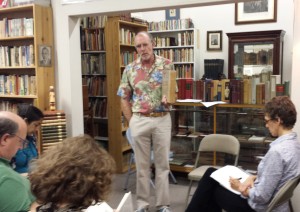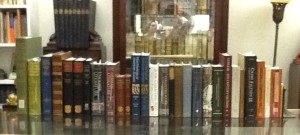There is a significant difference between booksellers who advertise their wares with professional descriptions, a clear understanding of the item in question, an honest assessment with regard to the item’s condition… and your typical eBay/Amazon blasters: “FREE SHIPPING! May or may not have highlighting and/or missing pages.” The pride in being a Good (or VG+) bookseller comes from the ability to sell something about which you are knowledgeable and which is priced confidently and accurately.
Oftentimes, as booksellers, we hear the question “Why?” Why is this book worth $495? Why would I pay that much for a book which Joe Shmoe, Bookseller offers for $29.99? There is no shame in asking these questions. Even booksellers can look at their colleagues’ wares and stare confusedly at the screen while waiting for the computer to sprout tiny-computer legs and giggle, while simultaneously erasing that last 0 or two. All that being said, however…. what can give booksellers the ability to price confidently and describe accurately? Two words.
If you are reading this blog, there is a good chance you have looked at listings of antiquarian books before and have noticed some crazy notations in our write-ups. What is a BAL11092? Or a Gabler G2390? An average person has a good chance of not particularly understanding what the numbers mean. Heck, another bookseller might not even have a clue to what you are referring. A good bookseller will know, however, that the inclusion of those small jumbles of letters and numbers beyond their edition statements represent the dedication and honesty of the person offering the item. They have gone to the trouble of understanding what they hold in their hands, so that their customer can have the guarantee and peace-of-mind that they are buying a 1st/1st, a 1st edition thus, or a reprint. What allows a reference book to (sometimes) up the price or (often) lower the price? Well… I guess you’ll just have to take the Tavistock Books’ Reference Book Workshop to find out!
This year’s course took place this past Saturday, the 23rd of August. The day-long course consists of an intense look at different genres of reference books, their scope, and their usefulness to the book-selling, book-collecting and book-cataloguing trades. Sections covered include Literature (do the acronyms NUC or NCBEL mean anything to you? Here’s where you will find them explained!), Americana (with an emphasis on Western Americana & California… can you say Kurutz three times fast?), Children’s Books, Early Printed Books, and Online Reference Tools. This course is a fast-paced survey, useful for any bookseller, collector, or librarian interested in understanding the tools booksellers use to identify and price their books.

This year’s workshop was attended by 4 booksellers (some new, some slightly seasoned), two librarians, and a lover of all things book-related. Intelligent questions were asked, anecdotes shared, and quite a bit of knowledge imparted on these smiling (though, by the end of the day, slightly haggard) faces. Due to the limited amount of space in the shop (where the workshop is held), we cap the number of “pupils” at 7 per year. Should you be interested in attending, please email msp@tavbooks.com and ask to be included on our mailing list, so that when the reminder comes about next spring to sign up, you can be first on the list!
The workshop truly is helpful to those dealing with the book-trade, and the Tavistock Books Reference Collection of over 3,000 reference volumes alone are worth the trip to see! And, as per tradition, lunch is on us at a great sushi place on our charming island of Alameda, CA. Interested in attending a workshop one day? Let us know!


